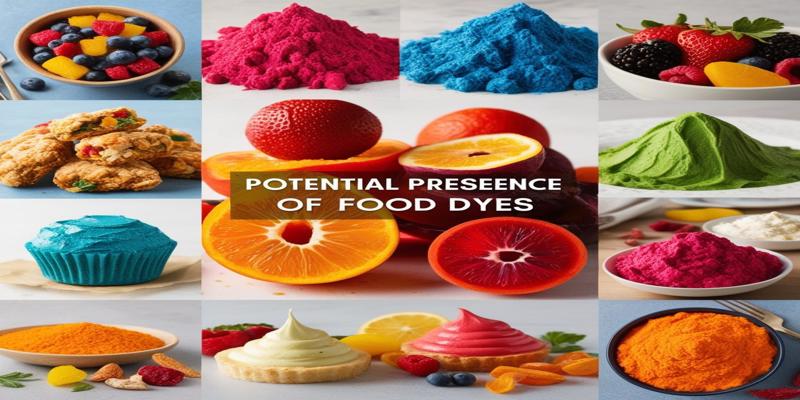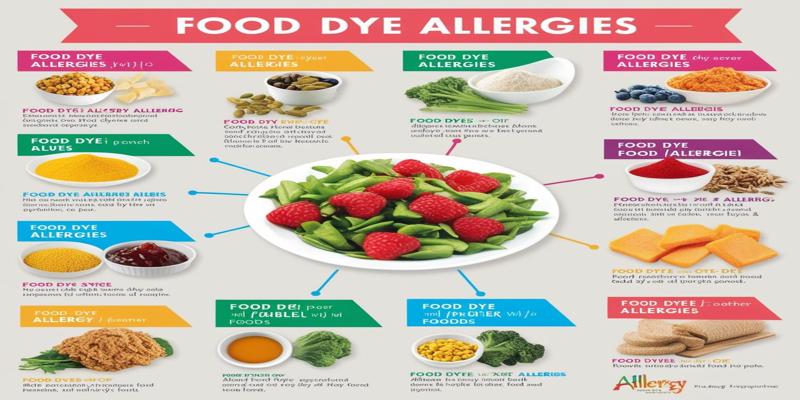Has that ever happened to you: unexplained allergic reactions after consuming certain foods or drinks? The perpetrator could be correct under your nose-artificial food dyes. They are everywhere-from cereals and candies to medications and cosmetics. Though generally recognized as safe by the regulating agencies, food dyes could give a reason for adverse reactions in sensitive people.
What are Food Dye Allergies?

Food dye allergies are adverse, hypersensitive reactions that follow ingesting food, drinks, and drugs that contain either artificial or natural colorants. Although the regulating authorities consider them safe generally, these dyes will provoke an allergic reaction in susceptible individuals. According to studies, the most offending agents were Red Dye 40, Yellow 5, and Yellow 6, constituting about 90% of the food dyes used in the United States.
Symptoms and Severity
Adverse reactions to food dyes can be both mild and severe. Typical symptoms include:
- Cutaneous effects: urticaria, pruritus, and flushing
- Gastrointestinal side effects: nausea, vomiting, diarrhea
- Respiratory effects: wheezing, cough
- Headache or migraine
In rare cases, severe reactions may signal the onset of anaphylaxis, characterized by shortness of breath, swelling in the face or throat, and dangerously low blood pressure.
Common Food Dyes and Their Sources
Following are some food dyes that have been reported to be responsible for allergic reactions:
- Carmine-red #4: The natural red dye is an insect derivative in foods, including red meat, yogurts, and candies.
- Tartrazine-yellow #5: Synthetic yellow dye found in many cereals, candies, and beverages.
- Annatto: Also known as natural yellow-orange dye, it causes reactions in UT patients.
Some research indicates that people allergic to certain foods are more likely to react to associated dyes. Thus, individuals with beef allergies may also respond to carmine.
Diagnosis and Management
Diagnosing food dye allergies can be challenging, as no specific tests are available. Healthcare providers often recommend keeping a detailed food diary to identify potential triggers. Sometimes, a supervised food challenge test may be necessary for accurate diagnosis.
Common Food Dyes and Their Potential Risks
Synthetic Dyes: A Rainbow of Concerns
Artificial food colors are synthetic, petroleum-based products that make a variety of foods more visually appealing. All food dyes have been linked to potential health issues. The FDA has approved the following artificial food dyes: Red 40, Yellow 5, Yellow 6, Blue 1, and Blue 2.
Health Implications
Studies have suggested a potential link between food dyes and hyperactivity in children, particularly those sensitive to these additives. However, the evidence remains mixed, and regulatory agencies consider the dyes safe at current usage levels. Some dyes, like Red 3, have raised concerns about carcinogenicity, though conclusive evidence is lacking.
Allergic Reactions and Sensitivities
Some artificial food colorings, such as Yellow 5, produce allergic reactions in some people. These reactions may range from simple skin rashes to more severe ones. People sensitive to any substance should be even more careful to avoid such artificial coloring agents.
Regulatory Landscape
The FDA has approved nine synthetic food dyes for use in foods in the United States. Yet many health experts argue that the "safe levels" currently set by the FDA are not adequately protecting consumers, especially children. On the other hand, the European Union has imposed warning labels on foods containing certain synthetic dyes due to concerns over health risks.
Minimizing Exposure
To reduce exposure to synthetic food dyes, consider the following steps:
- Reading ingredient labels carefully
- Staying away from foods with artificial food coloring
- Select products using an alternative natural dye
- Have additional resources available, like the Environmental Working Group Food Scores database, to make more informed decisions
Symptoms of a Food Dye Allergy

Knowledge of symptoms associated with a food dye allergy can help diagnose and treat any issues early on. While reactions will vary from person to person, there are many common symptoms to look out for.
Mild to Moderate Symptoms
Food dye allergies are usually skin-related. Hours after ingesting foods or drinks that contain food coloring, you may experience a flush, hives, or itchy skin. Other people also have headaches or GI symptoms, such as nausea, vomiting, or diarrhea.
Severe Reactions
A more severe food dye allergy can cause serious symptoms requiring immediate treatment. Such symptoms may include the following:
- Breathing problems or asthma
- Swelling of the face, lips, or throat
- Tightness of the chest
- Dizziness or lightheadedness
- Tachycardia and hypotension
Behavioral and Cognitive Effects
Surprisingly, there is some good evidence that some food dyes can cause behavioral effects, especially in children. These include hyperactivity, irritability, or even lack of concentration. Nevertheless, many more studies are needed to establish this very well.
Identifying the Culprit
If you suspect a food dye allergy, keeping a detailed food diary and noting any symptoms that surface after eating becomes crucial. Watch for processed foods, candies, beverages, and baked goods, often artificially colored. The most common offenders include Red 40, Yellow 5, Yellow 6, and Blue 1
Diagnosing and Treating Food Dye Allergies
Identifying the Culprits
Adverse food dye reactions are often complicated to diagnose, as the colorants are added to various foods. Some common food dyes known to result in allergic reactions are red #4 carmine, FD&C yellow #5 tartrazine, and annatto. Examples of these dyes could range from red meat to candies, drinks, and yogurts. It is, therefore, essential to note that those who already suffer from such things as peanut allergies are more likely to develop sensitivities against the food colorant.
Recognizing the Symptoms
Allergic reactions to food dyes can vary in severity and may present with different symptoms. These include cutaneous reactions such as urticaria and flush and gastrointestinal and respiratory effects, though in a few cases. Exposure to food dyes, on rare occasions, may cause anaphylaxis-severe, a potentially life-threatening allergic reaction, which is an emergency.
Diagnostic Approaches
Diagnosis of the food dye allergy is challenging since there are no uniform tests for these allergies. The healthcare professional may recommend that the patient maintain a food diary to detail what foods may set off symptoms. Sometimes, an elimination diet or a carefully controlled food challenge test may be advised to ascertain what dye caused the reaction. Diagnosis involves close interaction with an allergist or health professional to ensure safety and accuracy.
Conclusion
Alertness, education, and proactive communication are the keys to understanding and managing food dye allergy conditions. You can work around this pesky condition by knowing about common dye allergens, reading labels carefully, and working with health care providers.











